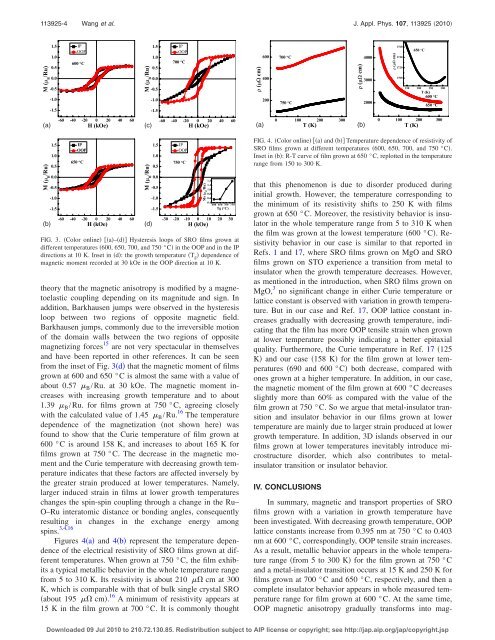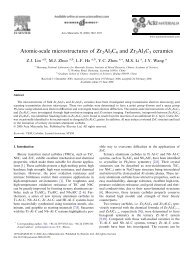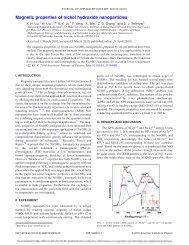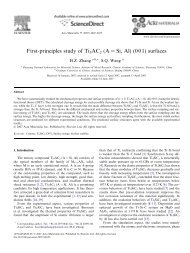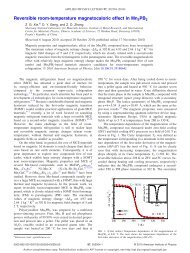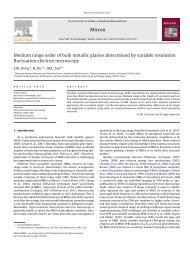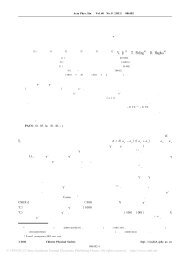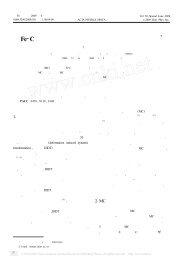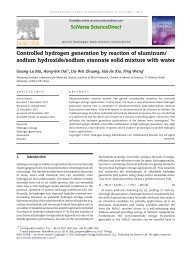Magnetic anisotropy and metal-insulator transition in SrRuO3 thin ...
Magnetic anisotropy and metal-insulator transition in SrRuO3 thin ...
Magnetic anisotropy and metal-insulator transition in SrRuO3 thin ...
Create successful ePaper yourself
Turn your PDF publications into a flip-book with our unique Google optimized e-Paper software.
113925-4 Wang et al. J. Appl. Phys. 107, 113925 2010<br />
(a)<br />
(c)<br />
(a)<br />
(b)<br />
FIG. 4. Color onl<strong>in</strong>e a <strong>and</strong> b Temperature dependence of resistivity of<br />
SRO films grown at different temperatures 600, 650, 700, <strong>and</strong> 750 °C.<br />
Inset <strong>in</strong> b: R-T curve of film grown at 650 °C, replotted <strong>in</strong> the temperature<br />
range from 150 to 300 K.<br />
(b)<br />
FIG. 3. Color onl<strong>in</strong>e a–d Hysteresis loops of SRO films grown at<br />
different temperatures 600, 650, 700, <strong>and</strong> 750 °C <strong>in</strong> the OOP <strong>and</strong> <strong>in</strong> the IP<br />
directions at 10 K. Inset <strong>in</strong> d: the growth temperature T g dependence of<br />
magnetic moment recorded at 30 kOe <strong>in</strong> the OOP direction at 10 K.<br />
theory that the magnetic <strong>anisotropy</strong> is modified by a magnetoelastic<br />
coupl<strong>in</strong>g depend<strong>in</strong>g on its magnitude <strong>and</strong> sign. In<br />
addition, Barkhausen jumps were observed <strong>in</strong> the hysteresis<br />
loop between two regions of opposite magnetic field.<br />
Barkhausen jumps, commonly due to the irreversible motion<br />
of the doma<strong>in</strong> walls between the two regions of opposite<br />
magnetiz<strong>in</strong>g forces 15 are not very spectacular <strong>in</strong> themselves<br />
<strong>and</strong> have been reported <strong>in</strong> other references. It can be seen<br />
from the <strong>in</strong>set of Fig. 3d that the magnetic moment of films<br />
grown at 600 <strong>and</strong> 650 °C is almost the same with a value of<br />
about 0.57 B /Ru. at 30 kOe. The magnetic moment <strong>in</strong>creases<br />
with <strong>in</strong>creas<strong>in</strong>g growth temperature <strong>and</strong> to about<br />
1.39 B /Ru. for films grown at 750 °C, agree<strong>in</strong>g closely<br />
with the calculated value of 1.45 B /Ru. 16 The temperature<br />
dependence of the magnetization not shown here was<br />
found to show that the Curie temperature of film grown at<br />
600 °C is around 158 K, <strong>and</strong> <strong>in</strong>creases to about 165 K for<br />
films grown at 750 °C. The decrease <strong>in</strong> the magnetic moment<br />
<strong>and</strong> the Curie temperature with decreas<strong>in</strong>g growth temperature<br />
<strong>in</strong>dicates that these factors are affected <strong>in</strong>versely by<br />
the greater stra<strong>in</strong> produced at lower temperatures. Namely,<br />
larger <strong>in</strong>duced stra<strong>in</strong> <strong>in</strong> films at lower growth temperatures<br />
changes the sp<strong>in</strong>-sp<strong>in</strong> coupl<strong>in</strong>g through a change <strong>in</strong> the Ru–<br />
O–Ru <strong>in</strong>teratomic distance or bond<strong>in</strong>g angles, consequently<br />
result<strong>in</strong>g <strong>in</strong> changes <strong>in</strong> the exchange energy among<br />
sp<strong>in</strong>s. 3,4,16<br />
Figures 4a <strong>and</strong> 4b represent the temperature dependence<br />
of the electrical resistivity of SRO films grown at different<br />
temperatures. When grown at 750 °C, the film exhibits<br />
a typical <strong>metal</strong>lic behavior <strong>in</strong> the whole temperature range<br />
from 5 to 310 K. Its resistivity is about 210 cm at 300<br />
K, which is comparable with that of bulk s<strong>in</strong>gle crystal SRO<br />
about 195 cm. 16 A m<strong>in</strong>imum of resistivity appears at<br />
15 K <strong>in</strong> the film grown at 700 °C. It is commonly thought<br />
(d)<br />
that this phenomenon is due to disorder produced dur<strong>in</strong>g<br />
<strong>in</strong>itial growth. However, the temperature correspond<strong>in</strong>g to<br />
the m<strong>in</strong>imum of its resistivity shifts to 250 K with films<br />
grown at 650 °C. Moreover, the resistivity behavior is <strong><strong>in</strong>sulator</strong><br />
<strong>in</strong> the whole temperature range from 5 to 310 K when<br />
the film was grown at the lowest temperature 600 °C. Resistivity<br />
behavior <strong>in</strong> our case is similar to that reported <strong>in</strong><br />
Refs. 1 <strong>and</strong> 17, where SRO films grown on MgO <strong>and</strong> SRO<br />
films grown on STO experience a <strong>transition</strong> from <strong>metal</strong> to<br />
<strong><strong>in</strong>sulator</strong> when the growth temperature decreases. However,<br />
as mentioned <strong>in</strong> the <strong>in</strong>troduction, when SRO films grown on<br />
MgO, 3 no significant change <strong>in</strong> either Curie temperature or<br />
lattice constant is observed with variation <strong>in</strong> growth temperature.<br />
But <strong>in</strong> our case <strong>and</strong> Ref. 17, OOP lattice constant <strong>in</strong>creases<br />
gradually with decreas<strong>in</strong>g growth temperature, <strong>in</strong>dicat<strong>in</strong>g<br />
that the film has more OOP tensile stra<strong>in</strong> when grown<br />
at lower temperature possibly <strong>in</strong>dicat<strong>in</strong>g a better epitaxial<br />
quality. Furthermore, the Curie temperature <strong>in</strong> Ref. 17 125<br />
K <strong>and</strong> our case 158 K for the film grown at lower temperatures<br />
690 <strong>and</strong> 600 °C both decrease, compared with<br />
ones grown at a higher temperature. In addition, <strong>in</strong> our case,<br />
the magnetic moment of the film grown at 600 °C decreases<br />
slightly more than 60% as compared with the value of the<br />
film grown at 750 °C. So we argue that <strong>metal</strong>-<strong><strong>in</strong>sulator</strong> <strong>transition</strong><br />
<strong>and</strong> <strong><strong>in</strong>sulator</strong> behavior <strong>in</strong> our films grown at lower<br />
temperature are ma<strong>in</strong>ly due to larger stra<strong>in</strong> produced at lower<br />
growth temperature. In addition, 3D isl<strong>and</strong>s observed <strong>in</strong> our<br />
films grown at lower temperatures <strong>in</strong>evitably <strong>in</strong>troduce microstructure<br />
disorder, which also contributes to <strong>metal</strong><strong><strong>in</strong>sulator</strong><br />
<strong>transition</strong> or <strong><strong>in</strong>sulator</strong> behavior.<br />
IV. CONCLUSIONS<br />
In summary, magnetic <strong>and</strong> transport properties of SRO<br />
films grown with a variation <strong>in</strong> growth temperature have<br />
been <strong>in</strong>vestigated. With decreas<strong>in</strong>g growth temperature, OOP<br />
lattice constants <strong>in</strong>crease from 0.395 nm at 750 °C to 0.403<br />
nm at 600 °C, correspond<strong>in</strong>gly, OOP tensile stra<strong>in</strong> <strong>in</strong>creases.<br />
As a result, <strong>metal</strong>lic behavior appears <strong>in</strong> the whole temperature<br />
range from 5 to 300 K for the film grown at 750 °C<br />
<strong>and</strong> a <strong>metal</strong>-<strong><strong>in</strong>sulator</strong> <strong>transition</strong> occurs at 15 K <strong>and</strong> 250 K for<br />
films grown at 700 °C <strong>and</strong> 650 °C, respectively, <strong>and</strong> then a<br />
complete <strong><strong>in</strong>sulator</strong> behavior appears <strong>in</strong> whole measured temperature<br />
range for film grown at 600 °C. At the same time,<br />
OOP magnetic <strong>anisotropy</strong> gradually transforms <strong>in</strong>to mag-<br />
Downloaded 09 Jul 2010 to 210.72.130.85. Redistribution subject to AIP license or copyright; see http://jap.aip.org/jap/copyright.jsp


